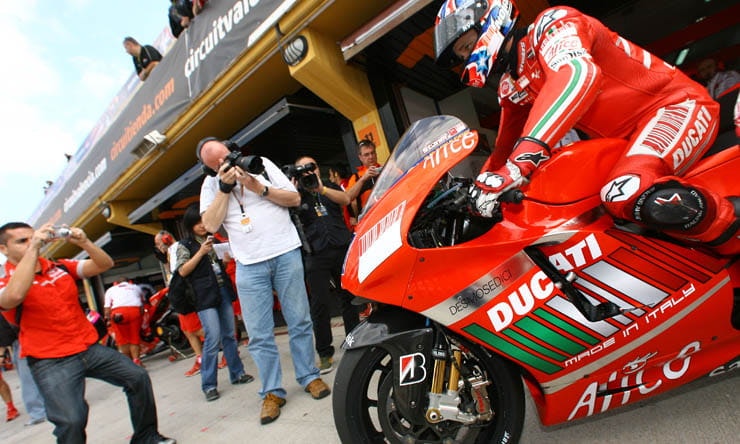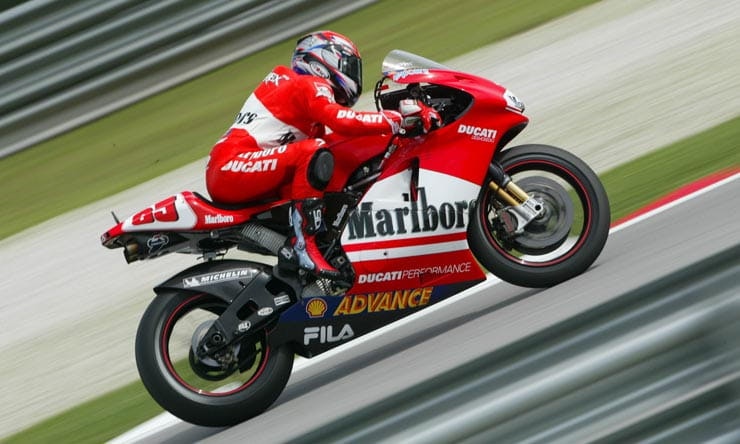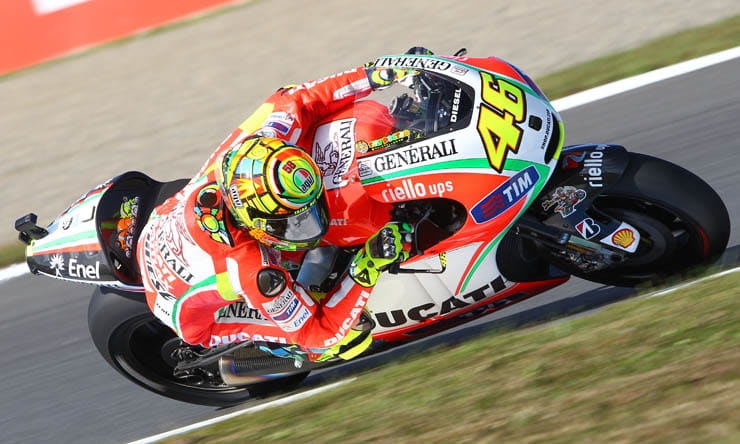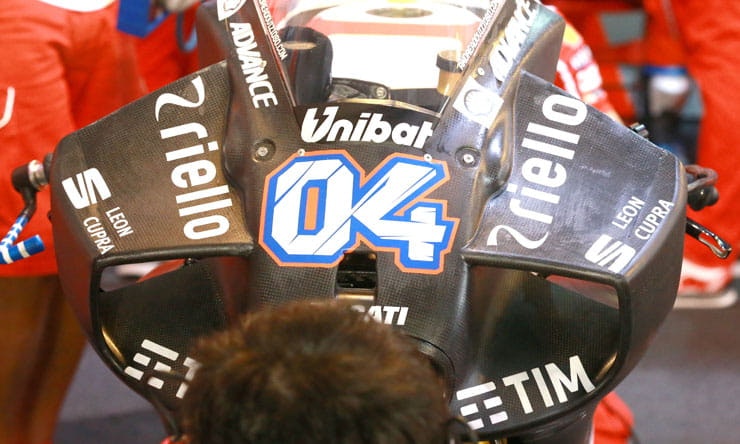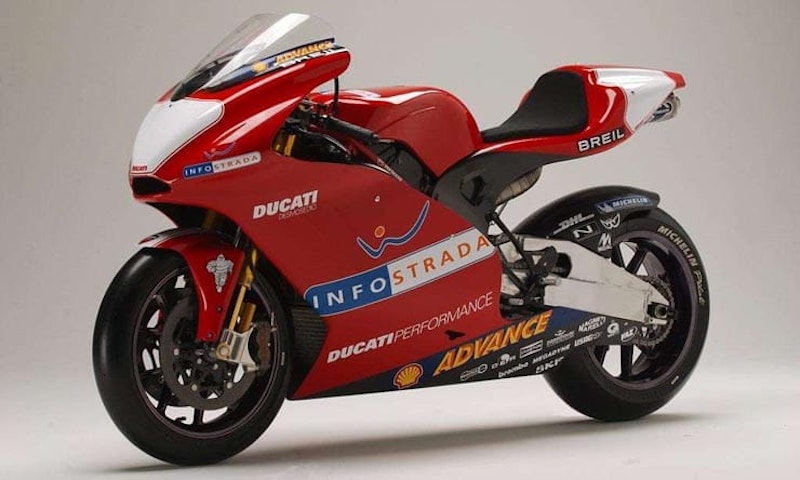The third part of our series marking the 15th anniversary of the MotoGP four-stroke series takes a look at one of the most innovative and popular bikes ever to have raced in any championship, the Ducati Desmosedici.
While it was late to the MotoGP party, entering a year after the series started, the Ducati made its mark straight away. Despite unconventional engineering and a fraction of the resources of the Japanese factories that dominated, the Ducati was instantly competitive.
It’s been through a huge range of design changes and seen its fortunes rise and fall dramatically from one year to another, but Ducati is one of only three firms to have taken championship titles since the start of the series, the others being Honda and Yamaha.
Gestation of the Desmosedici
Ducati dominated production-based world superbike racing in the 1990s but the switch to four-strokes for MotoGP meant the firm was inevitably interested in taking part.
Although it opted not to compete in 2002, the first year of the new series, Ducati made a public announcement of its intentions to enter MotoGP back in early 2001, two years before it would actually race. That announcement led to a year of speculation; what route would Ducati take?
Inside the firm, discussions were just as intense. With a strong reputation built around its Desmo V-twin engines, there was initially interest in making a twin-cylinder GP bike. Ducati was concerned that if it moved away from its trademark configuration, it would reflect badly on its road bikes. The first plan was to make an oval-piston V-twin, with eight valves per cylinder. While the 2002 regulations allowed such designs, they did add 10kg to the minimum weight for oval-pistoned engines, so such a twin would have to weigh the same 145kg as a four or five cylinder rival.
With oval pistons adding design complexity and no real advantage over a four-cylinder, the idea was dropped. Instead, Ducati opted to make a V4, but initially planned to use what it called a ‘Twinpulse’ arrangement. Each bank of pistons would rise and fall together and fire simultaneously, giving the same sort of sound and power delivery as a V-twin.
Ducati realised this arrangement would reduce peak power, but hoped that the improved traction and rideability would make up for it.
During testing, though, a conventional V4 arrangement was also tried, and found to result in faster lap times, so that’s what Ducati initially opted for when it started racing in 2003, while continuing to work on the Twinpulse – basically a big-bang version – behind the scenes.
Away from the engine, Ducati employed F1 aerodynamicist Alan Jenkins to help sculpt the Desmosecidi’s bodywork, while using its traditional skills with steel trelliswork to create a chassis unlike any other on the grid.
The first prototype broke cover in April 2002 and tested through the rest of the year to ensure it would be ready come the start of the 2003 season.
2003 Desmosedici GP3
Despite the plans for a V-twin replicating 'Twinpulse' engine, Ducati was more interested in being competitive than trying to persist with the idea that the Desmosedici was some sort of traditional V-twin in disguise. So the GP3 debuted with a conventional, screamer firing order.
Ducati claimed over 220bhp, and right from pre-season testing the combination of that engine and the slippery, F1-inspired bodywork meant the Desmosedici was the fastest GP bike of all in a straight line. That’s been a consistent theme for the Desmosedici ever since.
Technically, the bike was much like the prototype tested in 2002. The chassis was a minimalist trellis, with the engine already providing much of the structural strength – something Ducati would later take even further. The swingarm looked like a basic and brutal solution, and would be refined over time.
Heat quickly proved to be an issue, and soon the GP3 gained vents in the slab-sided fairing as a result.
On track, Ducati amazed with its performance, which surpassed expectations for a team new to MotoGP. Loris Capirossi took a podium in the bike’s first ever race, with third at Suzuka. After a string of retirements, his next finish was second place in Italy, followed by Ducati’s first MotoGP victory at the next race, Catalunya. Three further podiums took him to fourth in the title race. Teammate Troy Bayliss was sixth, with three third places to his name.
2004 Desmosedici GP4
In 2003, the Desmosedici set a speed record of 202.5mph, the fastest seen in MotoGP, but just a year later its successor achieved over 215mph at the IRTA tests in Catalunya.
Power was up to around 230bhp for 2004, and the bike’s fairing became even more complete – it was now impossible to even glimpse the engine or frame under the skin of carbon fibre. In fact, the chassis remained a steel trellis and the engine was a subtle evolution, revving a little higher to create its extra power. During the season the team also revisited the Twinpulse engine concept, starting from the Dutch round at Assen.
Aerodynamic changes includes new intakes on the tail along with slots in the top to allow the exhaust heat to escape. The swingarm was much less agricultural than the previous design, but still looks frail compared to later evolutions.
After the stunning first season, 2004’s results were disappointing. Ducati achieved only three podiums – a lone third place each for Capirossi, Bayliss and Ruben Xaus.
2005 Desmosedici GP5
Despite the GP4’s inability to reach the heights of its predecessor, Ducati stuck with much the same design into 2005. The big change was the switch from Michelin to Bridgestone rubber, with the French rubber having taken some of the blame for the 2004’s weak results.
The same Alan Jenkins aerodynamic concept remained, with just small tweaks to the bodywork around the tank and redesigned packaging around the tail where the exhausts exited. The swingarm evolved again, becoming more substantial. The big-bang, Twinpulse engine remained in use.
The results showed Ducati bouncing back, particularly in the second half of the year when Capirossi won twice on the Desmosedici, back-to-back in Japan and Malaysia.
2006 Desmosedici GP6
The 2005 and 2006 Desmosedicis would make for a tricky game of ‘spot the difference’ – they were virtually identical.
Given the strengthening results at the end of 2005 and the fact that everything was set to change in 2007, with the introduction of the 800cc class to replace the 990s, Ducati saw little to be gained in throwing a huge amount of development at the GP6. Subtle refinement was the order of the day, particularly in terms of electronics and rideability.
And with a win for Capirossi in the first round, it turned out that it was the right approach to have. Despite the lack of big, visible updates, the Desmosedici was on the way to its best year yet.
By the season’s end, Capirossi had scored three wins and four second place finishes on his way to third in the championship, just 23 points from champion Nicky Hayden. More memorable still was the return of Bayliss. Back in MotoGP for a one-off race at the season closer at Valencia after winning the world superbike championship, he took a jaw-dropping victory around the tight Spanish track.
2007 Desmosedici GP7
With the introduction of the new 800cc class in 2007 the general consensus was that handling and 250-style high corner speeds would be the route to success rather than the sledgehammer power of the previous generation of bikes.
Ducati disagreed. While the GP7 was a completely new bike, it followed the same thinking as its predecessors. A premium was put on top speed, power and aerodynamics. To regain power lost in with the decreased engine size the firm shifted back to a ‘screamer’ firing order, putting more faith than ever in the fast-improving field of electronic traction control.
Right from the start of the season it was clear that Ducati’s recipe was right and everyone else had got it spectacularly wrong.
Ducati’s other big surprise was Casey Stoner. Runner up to Dani Pedrosa in the 250 class in 2005, the Australian had earned a Honda satellite ride in 2006. He crashed a lot. On moving to Ducati most expected he’d play second fiddle to clear team leader Capirossi.
That didn’t happen. Instead Stoner won the first race, followed by another nine, easily trotting to his first world title and becoming a bone fide ‘alien’ in the process. Capirossi, meanwhile, won only once and rarely stepped on the podium.
2008 Desmosedici GP8
Once again, Ducati opted not to make big changes to its winning formula. The 2008 GP8 featured few visual updates compared to its predecessor.
However, the bike’s technology was one of the talking points of the season. Ducati’s electronics, already the strongest in 2007, were improved even further. The bike also got a lighter frame and tweaked rigidity to help reduce chatter. The rear suspension geometry was also revised.
They weren’t big changes, but such was the dominance of the 2007 Stoner-Ducati combination that making major alterations would have been stupid.
The 2008 season started with a win, but a resurgent Rossi proved impossible to beat over the course of the year. Stoner ended second overall, with six wins to Rossi’s nine.
Worryingly for Ducati, though, nobody else could make the Desmosedici perform in 2008 – the other three bikes on the grid barely broke into the top 10 all year.
2009 Desmosedici GP9
The Ducati GP9 was the most talked-about bike of 2009 for a simple reason; the old steel trellis frame was gone, replaced by a carbon-fibre monocoque that sat above the V4 engine. The motor itself formed the rest of the structural strength.
The theory was that it would be lighter and stiffer than the old trellis. It would also eliminate the variation from one chassis to another that Stoner had complained about – an unavoidable result of having multiple hand-welded tubes.
While the carbon chassis made a lot of waves, it’s worth remembering that every generation of Desmosedici had already used the engine as its main structure, with just a small trellis front chassis to attached the headstock to it.
For all the criticism that the carbon chassis would later receive, it performed well. Well enough, in fact, to ensure that the forthcoming Panigale road bike would use a similar monocoque design (albeit made of aluminium rather than carbon). In fact, the 2017 Superleggera road bike, Ducati’s first carbon-chassis production machine, owes its design ideas to the 2009 Desmosedici.
The 2009 bike’s aero was changed too, with a completely new tail shape and a more rounded nose.
It performed well. Stoner won the first race and another three later in the year, but any hopes of a championship defence were scuppered when he was struck with illness, missing three rounds. Again, he was the only man to be able to make a Ducati work, though.
2010 Desmosedici GP10
The GP10 stuck to the design of the previous year’s bike, but added a carbon-fibre swingarm to the mix to go with the carbon frame.
Notably, the firm alternated back to a big-bang firing order for 2010, moving away from the screamer it had used since the start of the 800cc era.
Its performance was still strong, with a trio of wins for Stoner and podiums in more than half the year’s racers. Even team mate Nicky Hayden, who’d struggled with the bike in 2009, saw improved results, even if he couldn’t manage better than a single third place finish.
Mid-season, the Ducati sprouted small winglets on the fairing sides. These small growths sparked interest but not widespread copying… That would come a few years later. They were also a hint of the front end grip problems that were to become a running issue for the Desmosedici for years to come.
2011 Desmosedici GP11
Any talk of the Ducati’s technical changes for 2011 was largely drowned out by the clamour of Valentino Rossi joining the squad.
With Stoner leaving for Repsol Honda, it was hoped that Rossi would be a more than capable replacement, giving the Italian a chance to race for a home-grown factory and leave the fractious relationship with former team mate Jorge Lorenzo in the past.
The bike was given a significant going-over, though. The winglets of late 2010 became a more permanent fixture and the nose was given a more bullet-like profile. At the sides, the large air outlets of previous versions were replaced with shark-like gills.
Ducati’s season was dire, though. Just as Stoner’s former team mates had struggled with the Desmosedici, Rossi and Hayden couldn’t get the bike to work for them. Neither managed better than third place, while Stoner strolled to a Honda-mounted title.
The problem was confidence. Riders complained they couldn’t feel the Ducati’s front end, and fingers were quickly pointed at the carbon frame. Was it too rigid? Did it prevent feedback reaching the rider? Few seemed to notice that the problems had been apparent for all Ducati riders other than Stoner all the way back to 2007, long before the carbon frame appeared.
Such were the 2011 problems that mid-season Ducati created the GP11.1, effectively a transition to the next year’s GP12 design. Since the GP12 was developed with a new 1000cc engine, with different mounts compared to the old 800, a special de-stroked version of the 2012-spec engine had to be made to suit the outgoing 2011 rules. It also adopted the seamless transmission intended for 2012.
The results still didn’t come, leading Ducati to drop the carbon frame and create a third version of the GP11, combining the GP11.1 engine with a handmade aluminium beam frame.
2012 Desmosedici GP12
Originally developed to have a carbon monocque combined with a new 1000cc version of the desmo-valved V4 to suit 2012’s new regulations, the struggles with the previous year’s GP11 and GP11.1 meant that the GP12 never actually appeared in that form.
Instead it got a development of the aluminium chassis that had shown up on the final version of the GP11.1.
The changes were wholesale. The alloy frame required a different rear suspension setup, with the swingarm braced from underneath rather than above and the shock repositioned. Carbon was still used for the swingarm, even if the material had been dropped for the main chassis.
The engine was, of course, the new 1000cc motor, and featured a seamless gearbox. Power, as with its rivals, was much higher than before – around 230bhp was quoted.
The performance was improved but still lacklustre. Rossi scored a couple of podiums, but decided that his future was back at Yamaha for the years to come.
2013 Desmosedici GP13
The continual efforts to tweak the frame design continued through 2013, with several different versions used during the year.
Engine power increased again, to around 235bhp, but the bike’s struggles continued. In fact, the lack of podium finishes for the whole year marked it as one of Ducati’s worst, throwing Rossi’s previous efforts into a positive light in retrospect.
Something had to change.
2014 Desmosedici GP14
For 2014, the Desmosedici looked very different to the bike that had started the previous year.
The aluminium frame was still there, but its shape was noticeably changed, and the fairing shape was also a break with previous models. The all-covering bodywork concept that had started with the first generation Desmosedici was gone, there was a new shape to the nose and its intake, a redesigned tail.
This was a strange period for MotoGP rules, with the introduction of the ‘Open’ class (previously the Claiming Rules Teams class). It meant bikes using spec MotoGP software would be eligible to use more engines during the year and given a larger fuel capacity.
Although aimed at smaller, privately owned, teams Ducati decided that it might benefit from the Open class rules and attempted to join. As a result, the structure was changed, creating a halfway house category – Factory with Open concessions – that the Desmosedici could operate in. It was supposed to help teams that hadn’t won during the previous year to catch up with their rivals in development terms.
If it sounds confusing, it’s because it was.
Results were improved, albeit fractionally and with the aid of regulatory concessions that some might argue gave an unrealistic advantage to the Ducati. It still didn’t trouble the podium often.
2015 Desmosedici GP15
The continuing struggles with the Desmosedici’s front end feel, despite the multiple frame changes, put an increasing focus on the engine as the culprit. Its layout was thought to compromise weight distribution and hamper the front end grip.
For the GP15 the engine was new. More compact than before, it was also rotated rearwards – to a more conventional V4 angle rather than the ‘L’ layout preferred in the past – to let its mass be moved forwards without interfering with the front wheel.
The whole bike is visibly smaller, tighter and sharper than the previous model. The frame is new, so is the swingarm and all the bodywork. Power was up again – over 240bhp – and unlike the GP14 the bike wasn’t eligible for ‘Open’ concessions. Its podiums the previous year meant it had to race on equal terms with Yamaha and Honda.
Results showed a gradual improvement, too. No wins, but both riders (Andrea Dovizioso and Andrea Iannone) achieved second and third place finishes on several occasions.
2016 Desmosedici GP16
Buoyed by indications that it was going the right direction, Ducati’s developments for the GP16 continued the themes set in 2015.
The frame got changed yet again, becoming a complex patchwork of welded aluminium panels, and the bodywork sprouted ever more extreme iterations of the winglets that were to become one of the year’s big talking points.
Power was now over 245bhp and the GP16’s seamless transmission was improved to an ‘evo’ version.
In a season that saw a wider range of winners than any in recent memory, the Ducati finally reached the top step of the podium again. Dovizioso won in Malaysia, Ianonne in Austria. While the team still didn’t threaten Honda or Yamaha, its overall points haul was closer to them than it has been for years.
2017 Desmosedici GP17
The launch bike shown for 2017 isn’t a radical departure from the 2016 version, but with the banning of winglets loses its predecessor’s extravagant bolt-on addenda.
The frame reflects evolutions made during 2016 and appears to be made of even more separate aluminium sections.
Ducati has also been working on a different set of bodywork with internal wings, aimed at regaining the front end downforce that it pioneered before the 2017 aero ban. Rules this year mean the bodywork design can only be changed once during the year, so the style Ducati chooses at the start of the season will be a vital indicator of how effective these internal winglets are.
The Desmosedici’s effect on production bikes
When Ducati introduced the V4 Desmosedici it was concerned that the engine layout might alienate it from its twin-cylinder traditions. In truth, it’s had no such effect. Ducati fans have proved that they want to see the firm winning, regardless of engine technology.
Of all the GP bikes on the grid, the Ducati actually turned out to be the first to make a big impact on production machines. Way back in 2004, just a year after it first raced, Ducati announced that a road-going version of the bike would be available in 2006.
The result was the Desmosedici RR (pictured above), a machine that was effectively identical to the early race bikes, with just enough technical changes to make it road legal. Lights, silencers, a bit of emissions-reducing kit – that’s about it.
Such was its popularity, despite a £40,000-plus price tag, that Ducati had to increase the planned production run. Eventually 1500 were made, with the limit set by the wearing out of the dies used to cast the engine cases rather than by any let-up in demand. To have made more, Ducati would have had to invest in much more expensive mass-production tooling for the engines.
Later, the carbon-framed Desmosedici GP9, maligned though it was, previewed the monocoque chassis concept that would later appear on the Panigale. Just this year the introduction of the 1299 Superleggera, with its carbon monocoque, shows that the 2009 Desmosedici learned valuable lessons for production machines.
